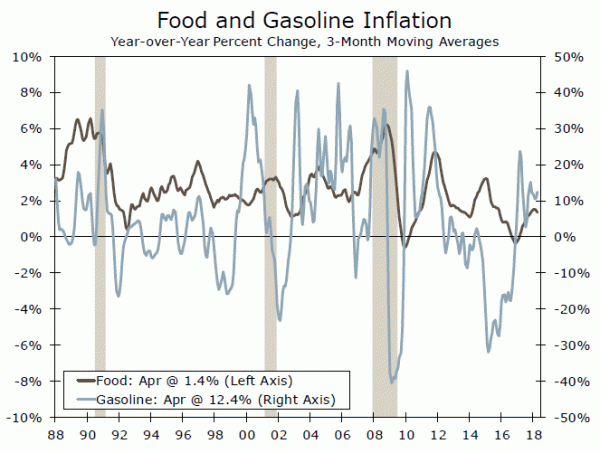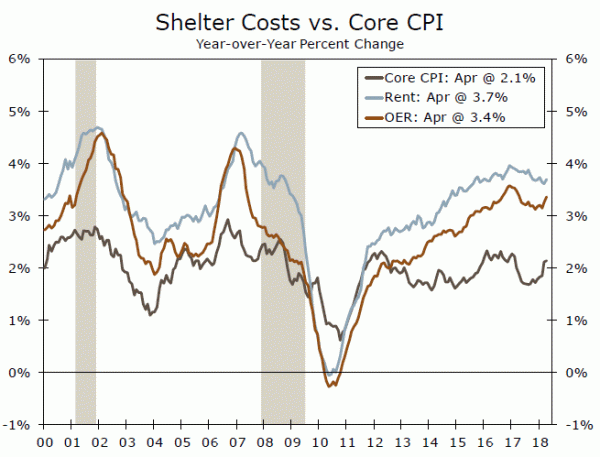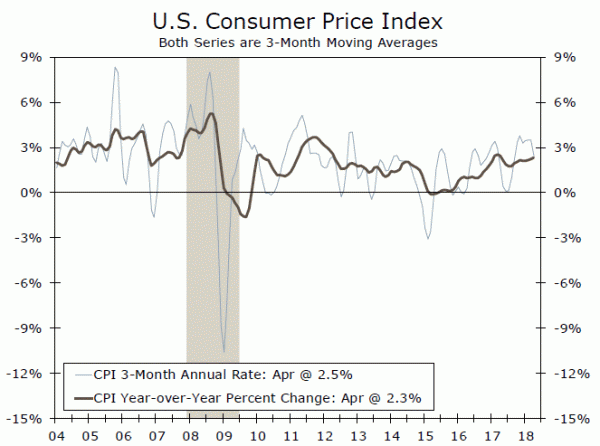CPI came in a little softer than expected in April (up 0.2 percent) amid a more tempered gain in the core index (up 0.1 percent). The softer core print likely reflects some exaggerated strength in Q1. The trend remains higher.
CPI Rebound in April
After slipping 0.1 percent in March, consumer price inflation strengthened in April with the index rising 0.2 percent. The pickup stemmed largely from the volatile energy and food components.
Energy prices reversed course in April, rising 1.4 percent after a pullback in March. Gasoline prices are beginning to put a noticeable dent in consumer purchasing power, having risen 13.4 percent over the past year.
Food prices increased 0.3 percent, which was the largest monthly gain in a little over a year. Although still running below overall CPI, food inflation has been strengthening over the past year as related commodity prices have been little changed and restaurants and other prepared food establishments have been contending with rising labor costs.
Core Eases, But Path Still Higher
After a hot first quarter, where core CPI rose at the fastest clip in 12 years, inflation ex-food and energy cooled in April. In our view, the slowdown likely reflects exaggerated strength early in the year, rather than an end to the strengthening trend in underlying inflation.
Core services inflation in April eased to 0.2 percent. Shelter prices, which account for about 40 percent of the core index, continue to be a primary source of support, having increased 0.3 percent. Softer monthly readings were seen in that category, however, as well as in medical and transportation services. Meanwhile, core goods were back in deflation territory for a second straight month (down 0.1 percent). Vehicle prices were the primary drag, down 0.9 percent, as demand for new vehicles has ebbed and the used car market is contending with a flood of off-lease vehicles.
Upward Trend Sufficient for Further Fed Hikes
Although inflation came in a bit softer than expected in April, we do not believe this will prevent the Fed from raising rates another three times this year. Over the past year, headline inflation is up 2.5 percent, compared to a 2.2 percent increase this time last year. What’s more, core inflation remained steady at 2.1 percent. Over the past 15 years, core CPI has run 0.2 percentage points above the core PCE deflator, making the current rate nearly in line with the Fed’s target.
We expect inflation to rise further in the months to come. Most immediately, the return of $70 oil stands to push up monthly readings of headline inflation at least through May. While we see oil falling in the second half of the year, prices are expected to remain above the levels that prevailed a year ago. Food-related commodity prices have also been fairly stable over the past year after falling from 2014 to early 2017. Core inflation should present a clearer sign of strengthening inflation. We expect core CPI to rise to 2.3 percent by Q3 as rising labor and material costs lead more firms to raise prices.















